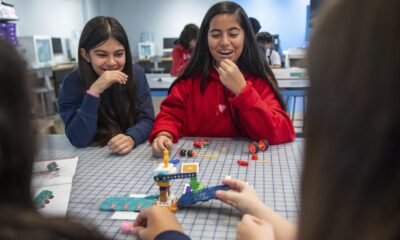Education
Colleges add sports to bring men, but it doesn’t always work
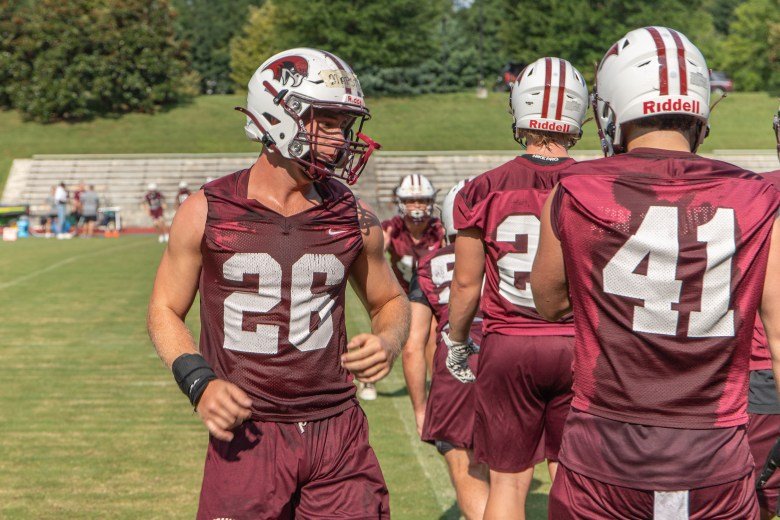
SALEM, Va. — On a hot and humid August morning in this southwestern Virginia town, football training camp is in full swing at Roanoke College. Players cheer as a receiver makes a leaping one-handed catch, and linemen sweat through blocking drills. Practice hums along like a well-oiled machine — yet this is the first day this team has practiced, ever.
In fact, it’s the first day of practice for a Roanoke College varsity football team since 1942, when the college dropped football in the midst of World War II.
Roanoke is one of about a dozen schools that have added football programs in the last two years, with several more set to do so in 2026. They hope that having a team will increase enrollment, especially of men, whose ranks in college have been falling. Yet research consistently finds that while enrollment may spike initially, adding football does not produce long-term enrollment gains, or if it does, it is only for a few years.
Roanoke’s president, Frank Shushok Jr., nonetheless believes that bringing back football – and the various spirit-raising activities that go with it — will attract more students, especially men. The small liberal arts college lost nearly 300 students between 2019 and 2022, and things were likely to get worse; the country’s population of 18-year-olds is about to decline and colleges everywhere are competing for students from a smaller pool.
“Do I think adding sports strategically is helping the college maintain its enrollment base? It absolutely has for us,” said Shushok. “And it has in a time when men in particular aren’t going to college.”
Women outnumber men by about 60 percent to 40 percent at four-year colleges nationwide. Roanoke is a part of this trend. In 2019, the college had 1,125 women students and 817 men.
This fall, Roanoke will have 1,738 students altogether, about half men and half women. But the incoming freshman class is more than 55 percent male.
“The goal was that football would, in a couple of years, bring in at least an additional hundred students to the college,” said Curtis Campbell, Roanoke’s athletic director, as he observed the first day of practice. “We’ve got 97 kids out there on the field. So we’re already at the goal.”
That number was 91 players as the season began, on Sept. 6 — and the Maroons won their first game, 23-7, over Virginia University of Lynchburg, on what Shushok called “a brilliant day full of community spirit and pride.”
“Our students were out in force, side by side with community members spanning the generations,” he said via email. “In a time when we all need more to celebrate and opportunities to gather, it is easy to say our first football game since 1942 was both historic and invigorating.”
Related: Interested in more news about colleges and universities? Subscribe to our free biweekly higher education newsletter.
In the NCAA’s Division III, where Roanoke teams compete, athletic scholarships are not permitted. Athletes pay tuition or receive financial aid in the same way as other students, so adding football players will add revenue. For a small college, this can be significant.
Shushok said it’s not just about enrollment, though: He wants a livelier campus with more school spirit. Along with football, he started a marching band and a competitive cheerleading team.
“It plays to something that’s really important to 18- to 22-year-olds right now, which is a sense of belonging and spirit and excitement,” said Shushok, who came to Roanoke after being vice president of student affairs at Virginia Tech. Its Division I football team plays in a 65,000-seat stadium where fans jump up and down in unison to Metallica’s “Enter Sandman” as the players take the field.
The Maroons play in the local high school stadium — it seats 7,157 — and pay the city of Salem $2,850 per game in rent. The college raised $1.3 million from alumni and corporate sponsors to get the team up and running.
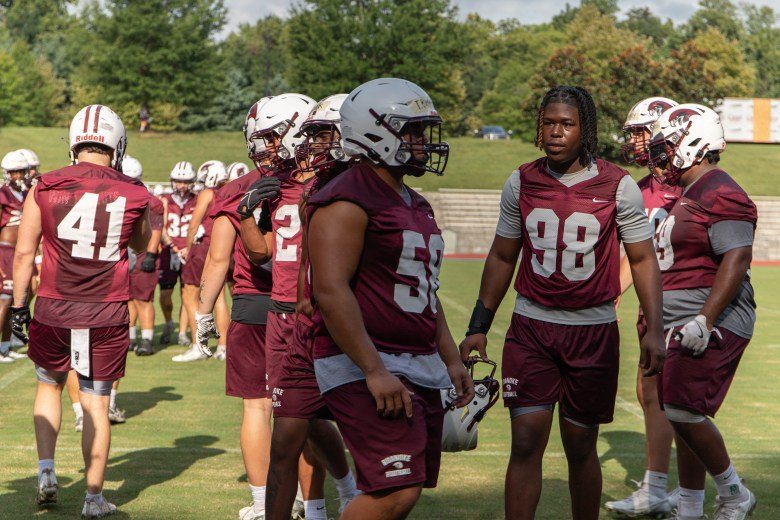
Despite the research showing limited enrollment gains from adding football, colleges keep doing it. About a dozen have added or relaunched football programs in the last two years, including New England College in New Hampshire and the University of Texas Rio Grande Valley. Several more plan to add football in 2026, including Chicago State University and Azusa Pacific University in California.
Related: Universities and colleges search for ways to reverse the decline in the ranks of male students
Calvin University in Michigan recently added football even though the student body was already half men, half women. The school wanted to broaden its overall appeal, Calvin Provost Noah Toly said, citing “school spirit, tradition, leadership development,” as well as the increased enrollment and “strengthened pipelines with feeder schools.”
A 2024 University of Georgia study examined the effects of adding football on a school’s enrollment.
“What you see is basically a one-year spike in male enrollment around guys who come to that school to help be part of starting up a team, but then that effect fades out over the next couple of years,” said Welch Suggs, an associate professor there and the lead author of that study. It found early modest enrollment spikes at colleges that added football compared to peers that didn’t and “statistically indistinguishable” differences after the first two years.
”What happens is that you have a substitution effect going on,” Suggs said. “There’s a population of students that really want to go to a football school; the football culture and everything with it really attracts some students. And there are others who really do not care one way or the other. And so I think what happens is that you are simply recruiting from different pools.”
Today, college leaders value any pool that includes men. Most prefer the campus population to be balanced between the sexes, and, considering the low number of male high school graduates going to college at all (39 percent in the last Pew survey), many worry about too few men being prepared for the future workforce.
“ I don’t know that we have done a good job of articulating the value, and of programming to the particular needs that some of our young men are bringing in this moment,” Shushok said. “I think it’s pretty obvious, if you read the literature out there, that a lot of men are feeling undervalued and perhaps unseen in our culture.”
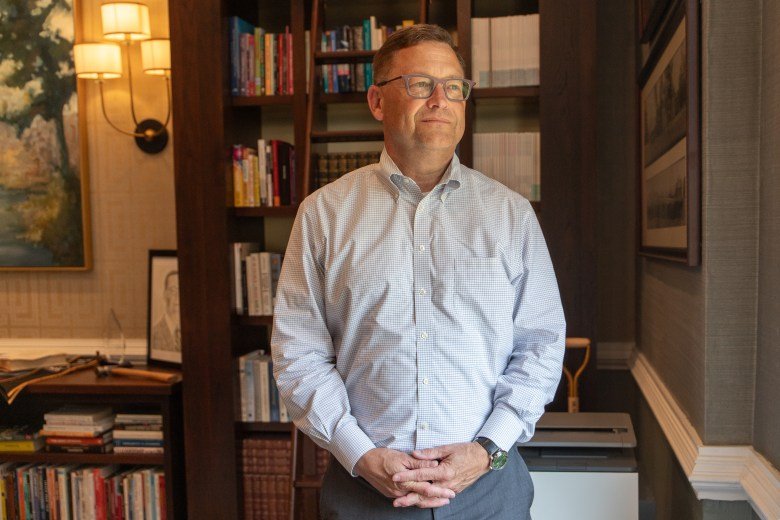
Shushok said that Roanoke’s enrollment-building strategy was not centered on athletics. The college has also forged partnerships with local community colleges, guaranteeing students admission after they complete their associate degree, and has added nine new majors in 2024, including cannabis studies. Shushok pointed out that while freshman enrollment is down slightly this year, the community college program has produced a big increase in transfer students, from 65 in fall of 2024 to 91 this fall.
About 55 percent of Roanoke’s students come from Virginia, but 75 of the football team’s 91 players are Virginians. The head coach, Bryan Stinespring, a 61-year-old Virginia native, knows that recruiting territory, having worked on the coaching staffs at several Virginia universities in his career.
Related: College Uncovered podcast: The Missing Men
When Stinespring took over as head coach in 2023, hoping to inspire existing students and potential applicants to join his new team, there was no locker room, no shoulder pads or tackling dummies, no uniforms.
“The first set of recruits that came on campus, we ran down to Dick’s, got a football, went to the bookstore, got a sweatshirt,” said Stinespring, referring to a local Dick’s Sporting Goods store. “These kids came on campus and they had to believe in the vision that we had.”
Students bought into that vision; 61 of them joined a club team last fall, which played four exhibition games in preparation for this year. The community bought in, too; 9,200 fans showed up to the first club game, about 2,000 of them perched on a grassy hill overlooking the end zone.
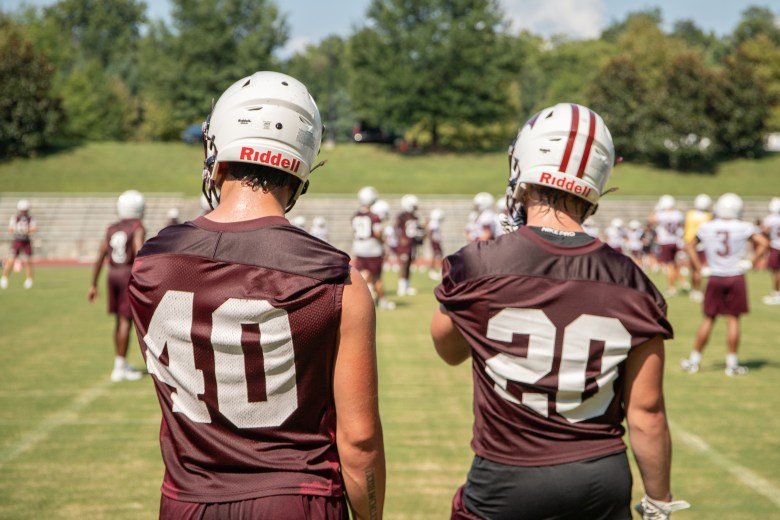
Before Ethan Mapstone, a sophomore, committed to Roanoke, he was on the verge of giving up football, having sustained several injuries in high school. Then Stinespring called.
“I could hear by the tone of his voice how serious he meant everything he was saying,” said Mapstone, a 6-foot-1-inch linebacker from Virginia Beach. “I was on a visit a week later, committed two weeks later.”
To him, the football leaders at Roanoke seemed to be “a bunch of people on a mission ready to make something happen, and I think that’s what drove me in.”
Related: Even as women outpace men in graduating from college their earnings remain stuck
KJ Bratton, a junior wide receiver and transfer student from the University of Virginia, said he was drawn to Roanoke not because of football but because of the focus on individual attention in small classes. “You definitely get that one-on-one attention with your teacher, that definitely helps you in the long run,” said Bratton.
Jaden Davis, a sophomore wide receiver who was an honor roll student in high school, said, “ The staff, they care about all the students. They’ll pull you aside, they know you personally, they’ll send you emails, invite you to office hours, and they just work with you to do the best you can.”
Not everyone was on board with football returning to the college when the plan was first announced. Some faculty and administrators were concerned football would change the campus culture, said Campbell, the athletic director.
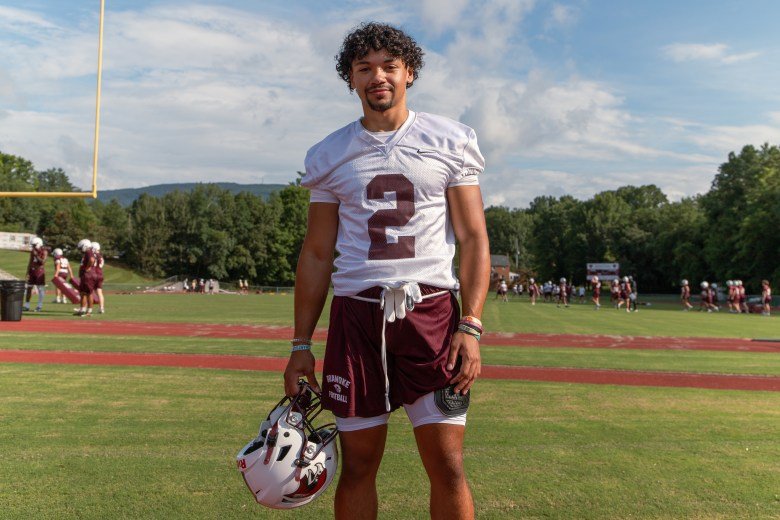
“There were just stereotypes about football players,” he said. “You know, they’re not smart, they’re troublemakers. They’re gonna do this and they’re gonna do that, be disruptive.”
But the stereotypes turned out to be unwarranted, he said. When the club team started, he said, “I got so many compliments last year from faculty and staff and campus security about how respectful and polite and nice our students were, how they behaved in the classroom, sitting in the front row and just being role models.”
Payton Rigney, a junior who helps out with the football team, concurred. “All the professors like them because they say ‘yes, sir’ and ‘no, ma’am,’” she said.
Like most Division III athletes, the Roanoke players know that they have little chance of making football a professional career. Mapstone said there are other reasons to embrace the sport.
“It’s a great blessing to be able to do what we do,” he said. “There’s many people that I speak to who are older and, and they reminisce about the times that they had to play football, and it’s very limited time.
“And even though there’s not a future for it, I love it. It’s a Thursday, my only problem in the world is that there’s dew on my shoes.”
Contact editor Lawrie Mifflin at (212) 678-4078 or mifflin@hechingerreport.org.
This story about college football was produced by The Hechinger Report, a nonprofit, independent news organization focused on inequality and innovation in education. Sign up for the Hechinger higher education newsletter.
Education
FIORENTINO: STATE SYSTEM WILL TACKLE AI EDUCATION

In his new blog, State System of Higher Education Chancellor Christopher Fiorentino highlights an agreement signed with Google last week “to help students develop the AI competencies they will need in their future careers.” Writing that the State System can’t fool itself into thinking artificial intelligence is a “trend” or a “passing fancy,” Fiorentino pledges to enter the future with “eyes wide open.” He says perhaps the best contribution the state-owned universities can make is to ensure graduates know “what AI tools they should be prepared to use” as they start their careers.
The agreement to expand the State System’s partnership with Google includes IUP, Cheyney, East Stroudsburg, PennWest, and Millersville..
THE CHANCELLOR’S BLOG:
https://chancellorfiorentino.blogspot.com/2025/09/ai-is-not-fad.html
.
Education
AI in healthcare education: The future of learning explained

Artificial Intelligence (AI) is no longer just a tool for diagnostics; it is transforming the way healthcare professionals learn, train, and prepare for real-world practice. From medical students to practicing clinicians, AI-powered platforms are redefining education with immersive simulations, adaptive learning, and real-time feedback. Industry leaders weigh in on how AI is shaping the future of medical training.
AI AS A PERSONALISED LEARNING COMPANION
According to Ankit Modi, Founding Member & Chief Product Officer at Qure.ai,
“Artificial Intelligence is redefining healthcare education by enabling immersive, data-driven, and personalised learning experiences. AI-powered tools like virtual simulations, adaptive learning platforms, and predictive analytics are bridging the gap between theoretical knowledge and real-world clinical skills.”
He highlights that AI allows students to practice procedures in safe, simulated environments while improving decision-making and knowledge retention.
MAKING CLINICAL TRAINING IMMERSIVE AND ACCESSIBLE
Mr. Tejasvi Rao Veerapalli, CEO of Apollo Hospitals, Hyderabad, stresses the role of AI in scaling high-quality training:
“AI is revolutionising healthcare education by making clinical training more immersive, personalised, and efficient. Through intelligent simulation tools, real-time feedback, and adaptive learning platforms, students and professionals can now build skills in risk-free environments that mirror real-world scenarios.”
He adds that AI ensures deeper knowledge retention and bridges gaps in training access and expertise.
AI AS A MENTOR FOR FUTURE CLINICIANS
For Jeevan Kasara, Director & CEO of Steris Healthcare, AI is evolving beyond diagnostics to act as a learning mentor:
“Artificial Intelligence is revolutionising healthcare education, evolving from a diagnostic aid to a personalised mentor for future clinicians. Virtual patients strengthen diagnostic reasoning, adaptive assessment tailors learning to individual needs, and natural language tools make information instantly accessible.”
He emphasises that this transformation equips professionals with sharper skills, long-term retention, and empathetic patient care.
MOVING BEYOND TEXTBOOKS TO DYNAMIC LEARNING
Rustom Lawyer, Co-Founder and CEO of Augnito, sees AI as a bridge between static theory and interactive practice:
“Artificial Intelligence is ushering in a new era for healthcare education, firmly bridging the gap between theory and practice. By offering realistic simulations, personalised learning experiences, and real-time feedback, these technologies empower students and professionals to develop skills with greater confidence and accuracy.”
He notes that this shift accelerates training while making knowledge retention stronger and more practical.
THE FUTURE OF MEDICAL EDUCATION WITH AI
Across perspectives, one theme stands out: AI is not just a technological upgrade, but a pedagogical revolution. It makes education:
-
More immersive through simulations.
-
More personalised with adaptive learning.
-
More impactful with real-time feedback and recall.
By tailoring education to individual needs while keeping pace with advancing medicine, AI ensures the next generation of healthcare professionals are better equipped, more confident, and more empathetic from day one.
– Ends
Education
How to use ChatGPT at university without cheating: ‘Now it’s more like a study partner’ | University guide

For many students, ChatGPT has become as standard a tool as a notebook or a calculator.
Whether it’s tidying up grammar, organising revision notes, or generating flashcards, AI is fast becoming a go-to companion in university life. But as campuses scramble to keep pace with the technology, a line is being quietly drawn. Using it to understand? Fine. Using it to write your assignments? Not allowed.
According to a recent report from the Higher Education Policy Institute, almost 92% of students are now using generative AI in some form, a jump from 66% the previous year.
“Honestly, everyone is using it,” says Magan Chin, a master’s student in technology policy at Cambridge, who shares her favourite AI study hacks on TikTok, where tips range from chat-based study sessions to clever note-sifting prompts.
“It’s evolved. At first, people saw ChatGPT as cheating and [thought] that it was damaging our critical thinking skills. But now, it’s more like a study partner and a conversational tool to help us improve.”
It has even picked up a nickname: “People just call it ‘Chat’,” she says.
Used wisely, it can be a powerful self-study tool. Chin recommends giving it class notes and asking it to generate practice exam questions.
“You can have a verbal conversation like you would with a professor and you can interact with it,” she points out, adding that it can also make diagrams and summarise difficult topics.
Jayna Devani, the international education lead at ChatGPT’s US-based developer, OpenAI, recommends this kind of interaction. “You can upload course slides and ask for multiple-choice questions,” she says. “It helps you break down complex tasks into key steps and clarify concepts.”
Still, there is a risk of overreliance. Chin and her peers practise what they call the “pushback method”.
“When ChatGPT gives you an answer, think about what someone else might say in response,” she says. “Use it as an alternative perspective, but remember it’s just one voice among many.” She recommends asking how others might approach this differently.
That kind of positive use is often welcomed by universities. But academic communities are grappling with the issue of AI misuse and many lecturers have expressed grave concerns about the impact on the university experience.
Graham Wynn, pro-vice-chancellor for education at Northumbria University, says using it to support and structure assessments is permitted, but students should not rely on the knowledge and content of AI. “Students can quickly find themselves running into trouble with hallucinations, made-up references and fictitious content.”
Northumbria, like many universities, has AI detectors in place and can flag submissions where there is potential overreliance. At University of the Arts London (UAL) students are required to keep a log of their AI use to situate it in their individual creative process.
As with most emerging technologies, things are moving quickly. The AI tools students are using today are already common in the workplaces they will be entering tomorrow. But university is not just about the result, it is about the process and the message from educators is clear: let AI assist your learning, not replace it.
“AI literacy is a core skill for students,” says a UAL spokesperson, before adding: “Approach it with both curiosity and awareness.”
-

 Business2 weeks ago
Business2 weeks agoThe Guardian view on Trump and the Fed: independence is no substitute for accountability | Editorial
-
Tools & Platforms1 month ago
Building Trust in Military AI Starts with Opening the Black Box – War on the Rocks
-

 Ethics & Policy2 months ago
Ethics & Policy2 months agoSDAIA Supports Saudi Arabia’s Leadership in Shaping Global AI Ethics, Policy, and Research – وكالة الأنباء السعودية
-

 Events & Conferences4 months ago
Events & Conferences4 months agoJourney to 1000 models: Scaling Instagram’s recommendation system
-

 Jobs & Careers3 months ago
Jobs & Careers3 months agoMumbai-based Perplexity Alternative Has 60k+ Users Without Funding
-

 Podcasts & Talks2 months ago
Podcasts & Talks2 months agoHappy 4th of July! 🎆 Made with Veo 3 in Gemini
-

 Education2 months ago
Education2 months agoVEX Robotics launches AI-powered classroom robotics system
-

 Education2 months ago
Education2 months agoMacron says UK and France have duty to tackle illegal migration ‘with humanity, solidarity and firmness’ – UK politics live | Politics
-

 Podcasts & Talks2 months ago
Podcasts & Talks2 months agoOpenAI 🤝 @teamganassi
-

 Funding & Business3 months ago
Funding & Business3 months agoKayak and Expedia race to build AI travel agents that turn social posts into itineraries




















